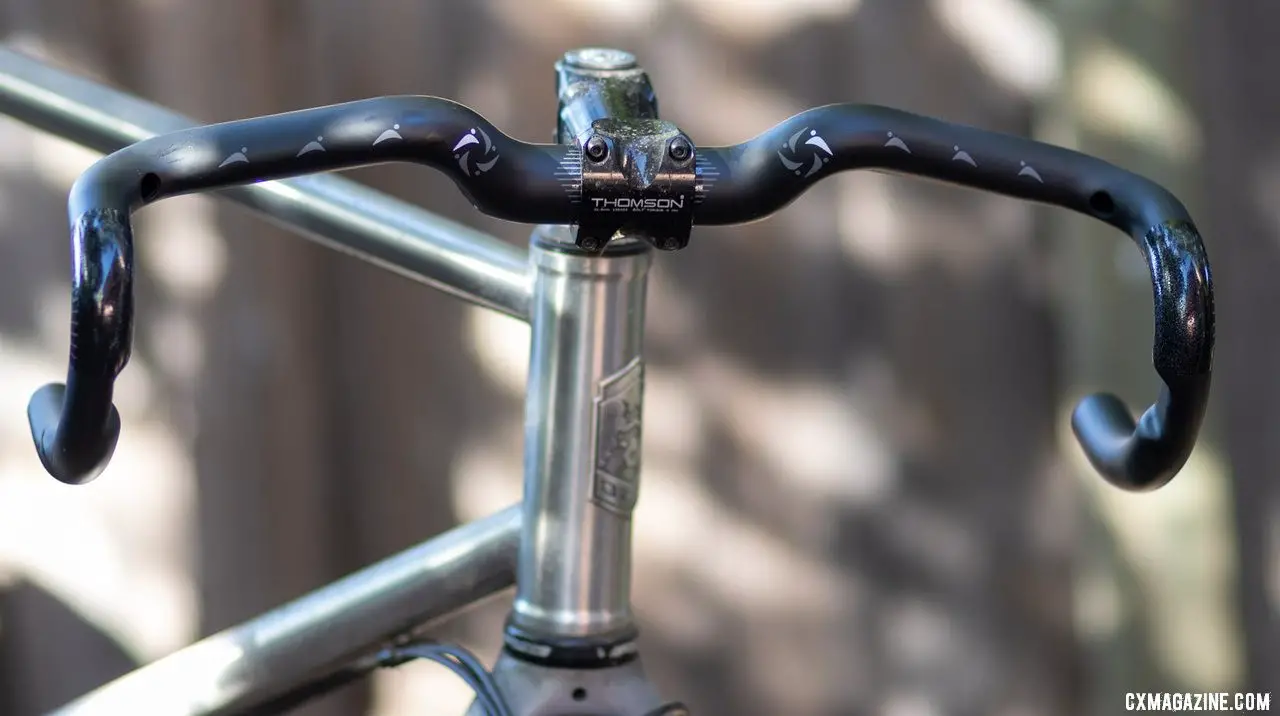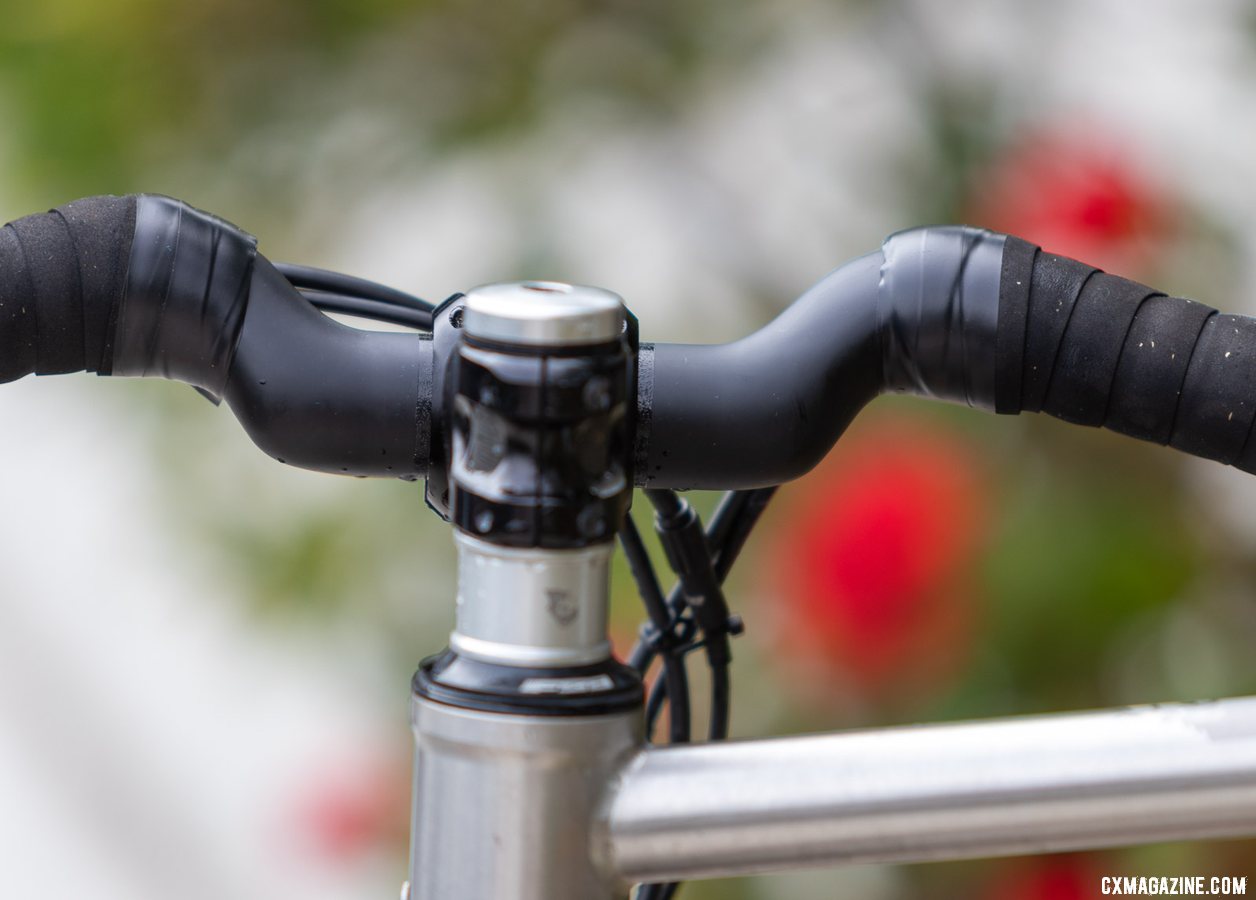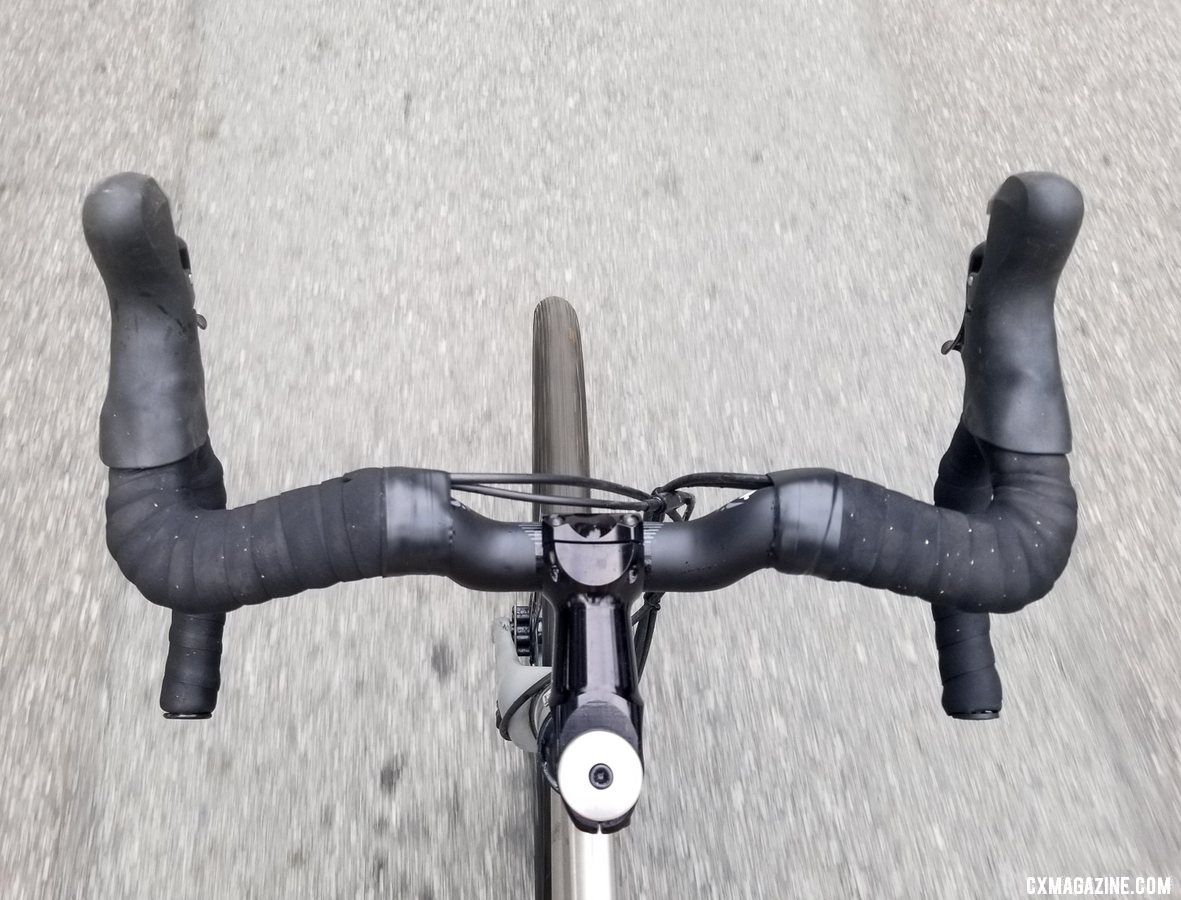Drop handlebars sure have thrown us for a curve recently. We’ve seen bars add rise, flare, top sweep and outsweep, many with the offroad drop-bar cyclist in mind. We thought we’ve seen it all, until this arrived:
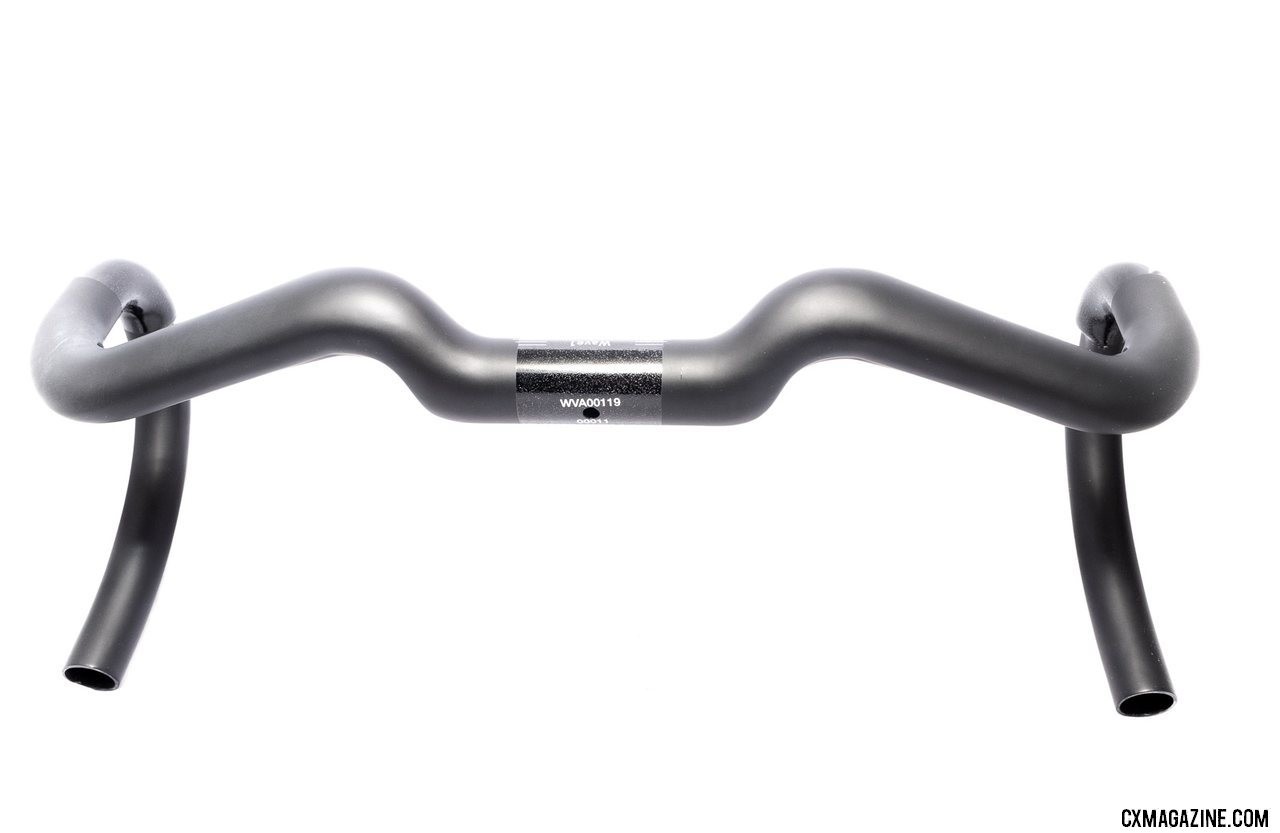
The Wave carbon handlebar from Coefficient Cycling features a unique 15-degree slope on the tops. © A. Yee / Cyclocross Magazine
Coefficient Cycling’s Wave handlebar makes other drop bars look, well, quite flat. Could the extra curvy, curly bar be just what the doctor ordered to add speed and comfort to your cyclocross or gravel ride?
A Wavy Path to a Curvy Bar
Coefficient Cycling’s Don Sheff wasn’t content with any of the existing permutations of handlebar bends. The cardiovascular perfusionist had no bike industry experience, but that didn’t stop him from taking matters into his own hands, literally. He dialed around to find a manufacturing partner, built rideable and 3D-printed prototypes and held out an early version at Sea Otter in 2016 in hopes of finding welcoming hands and nodding heads.
One welcoming, connected hand was all that Sheff needed, and he found it in former frontman of the Sea Otter Classic, Rick Sutton. Sutton liked the idea, tried out the bar and soon was company co-founder and COO.
Sutton enjoyed the ride while cruising on the bar’s tops, but felt the rest of the bar needed some tweaks. The former Vice President of Retail Services at Specialized used his industry connections to help refine the design and line up carbon manufacturing.
The process, just like the Wave handlebar’s lines, wasn’t a direct path to a finished product. Some might even call the path meandering, or even, wavy. But with time, countless prototypes and testing, they got there.
Roughly three years later from Sheff and Sutton’s meeting, we had a $329, 200-gram production handlebar in our hands for testing.
Sutton praised the bar’s hand positions as ideal for gravel. I was anxious to find out if my hands and arms would agree.
Ride the Wave
The Wave handlebar can overwhelm you with stats. It’s got rise, flare, sweep, slope and then some.
We’ll give you the two most will care about. Our 42cm test bar weighed just 201 grams and retails for $329, direct-to-consumer only. If that doesn’t get your blood pumping in excitement or fear, Coefficient Cycling’s images should illustrate the other measurements you might care about:
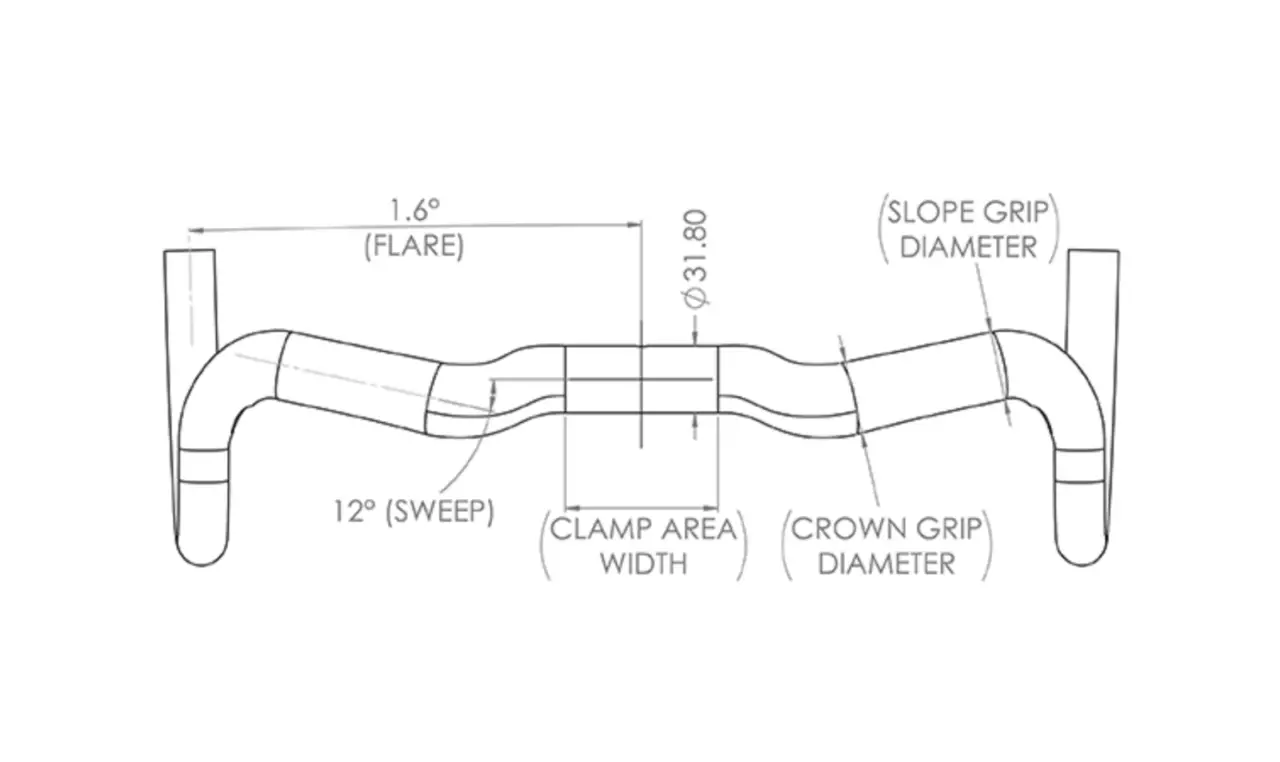
 The bar comes in four widths, with 38, 40, 42 and 44cm. Our 42cm test bar tipped the scales at a paltry 201 grams.
The bar comes in four widths, with 38, 40, 42 and 44cm. Our 42cm test bar tipped the scales at a paltry 201 grams.
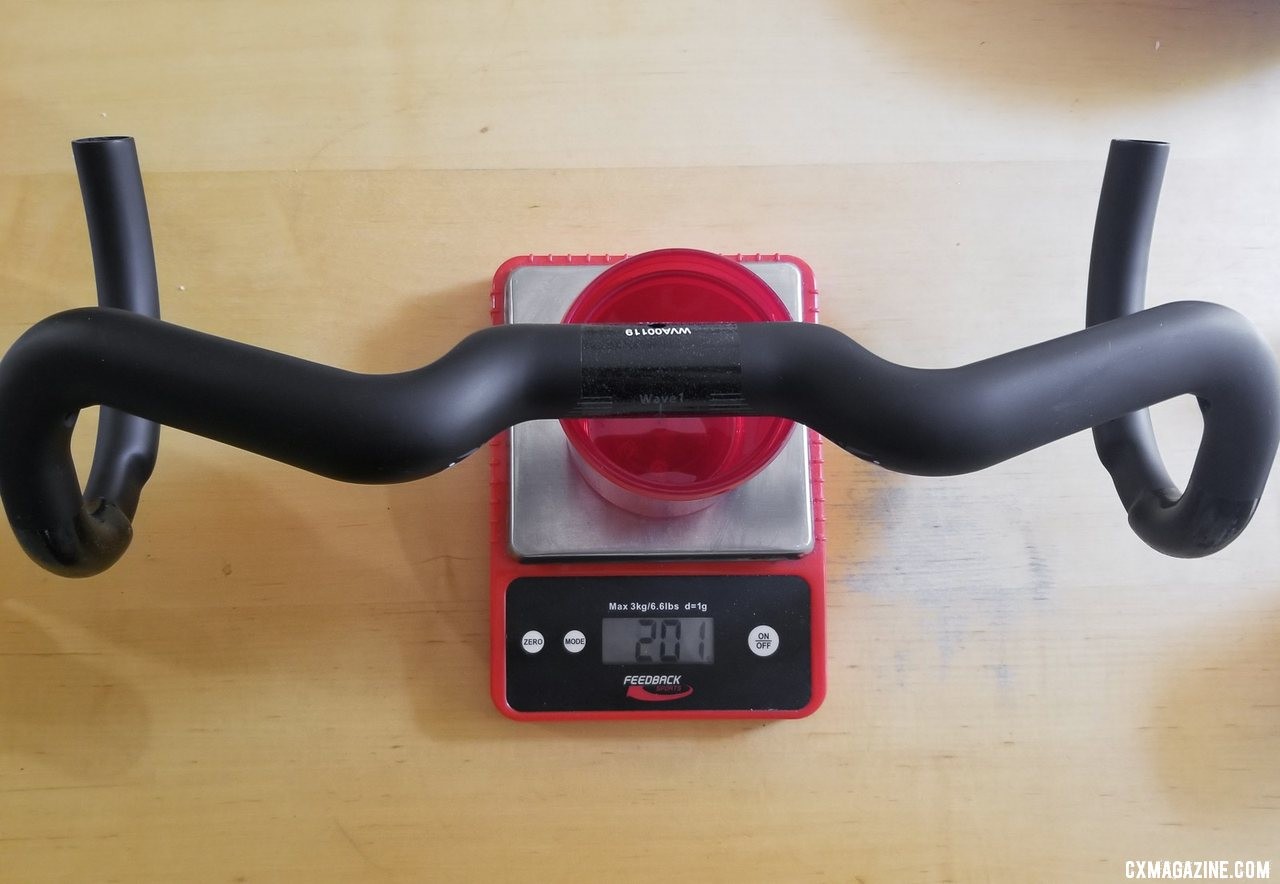
More bends doesn’t mean more grams. The Wave carbon handlebar from Coefficient Cycling. © A. Yee / Cyclocross Magazine
They feature relatively common 120mm drop and 77mm reach. It’s the rise paired with the slope up top that really differentiates the Wave.
Of course, handlebars are such personal items. Two riders of identical builds often prefer dramatically different handlebars. One might like a wide bar with a shallow drop and massive flare, while another may grab a narrow bar with a deep drop and no flare.
Companies like Zipp, Pro Components and Easton have launched handlebars under a strict media embargo, unveiling the XPLR flared bar, Discover carbon bar, and AX Series flared bars, respectively. Each launch suggested revolutionary innovation that needed to be kept under wraps, but in reality, they were mostly variations of existing bars. Those variations may agree with your riding style and terrain, but will they send consumers dropping their current bar to run to their retailer to get the new angled bend? It’s unlikely.
The Wave handlebar is arguably a big departure from other bar designs (except this one, which has led to a legal barfight covered by Bicycle Retailer). Could the design really change a riding experience enough to send cyclocrossers and gravel cyclists furiously paddling to catch the wave?
Hanging Ten on Top
I quickly installed the Wave on a gravel bike with Ultegra hydraulic disc brakes and an 11-speed mechanical drivetrain, anxious to hit the road, gravel paths and trails. While I didn’t bother to internally route the hoses or cable housing, the Wave handlebar has internal routing options for hoses, wires and cables.
To avoid any unnecessary wrenching for a handlebar I wasn’t sure if I’d like, I routed everything externally.
My first impression mirrored Sutton’s initial impression of Sheff’s early prototype. Riding the bar’s tops is really comfortable. The 12° backsweep felt familiar, a more extreme version of the 3t Morphe and Ritchey Biomax handlebars I used to covet and hoard.
It’s the 15° slope that angles down towards the drops that really feels different. The slope of the tops encourages you to drop your shoulders, relax your elbows and just cruise along. The hand position feels natural, similar to the way your hands rest on a keyboard—not perfectly flat—but angled so that the outer edge of your palms rest first. After some time on the Wave bar, other bars’ tops start to feel pretty awkward.
The Wave’s sweep and slope, paired with the rise near the stem clamp, put you in a comfortable, upright and relaxed position that’s conducive to cruising on non-technical terrain. Think road riding or smooth gravel pack riding, in a position that relaxes your entire upper body and has you breathing easy. It transforms your bike into a drop-bar cruiser.
It’s also a comfortable position for seated climbing, like a long gravel climb that never ends.
It’s not a position that feels superior for technical riding or cyclocross racing, however. At least for me, on bumpy cyclocross courses, the comfy raised and sloped tops seem to keep asking, “What’s the rush?” It’s a relaxed position that feels at home on smooth terrain while spinning. But on rougher, more technical terrain, I did not feel the position to be confidence-inspiring. I’d rather be wider and lower, especially when the terrain is bumpy (but I don’t need my brakes).
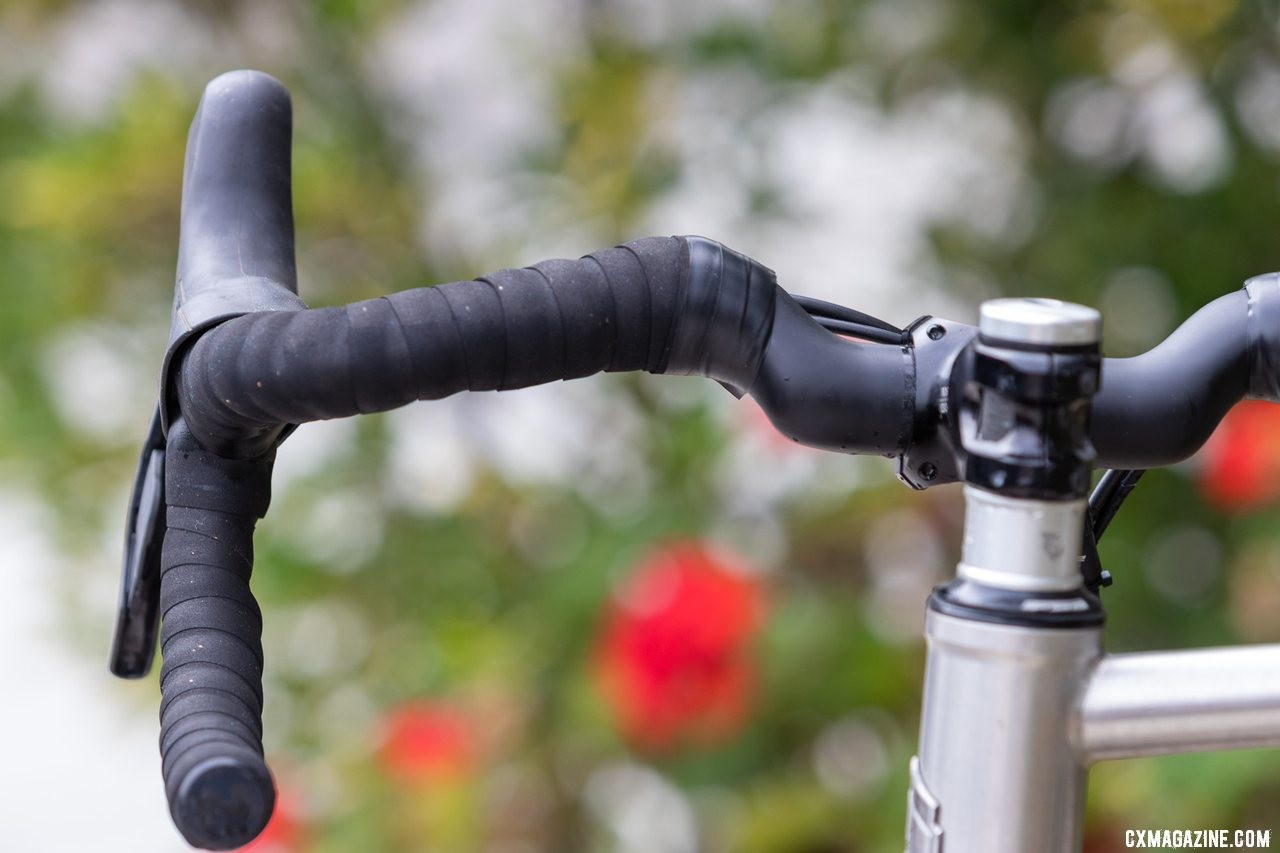
The Wave carbon handlebar from Coefficient Cycling features lots of slope and sweep but little flare. © A. Yee / Cyclocross Magazine
Sure, you could lower your stem to offset the rise for a more aggressive position, but that would also lower your position in the hoods and drops. The natural hand position up top is raised a bit, and a tad narrow because your thumbs end up locked into the bend by the clamp area.
Familiar NeighborHoods
Many of us spend much of our time riding in the hoods, and that’s where the Wave handlebar feels most normal. The reach (77mm) and shape by the hoods mimic many other popular bars. Riding in the hoods while blindfolded (which I don’t recommend), you’d be hard-pressed to feel like you’re riding a unique handlebar.
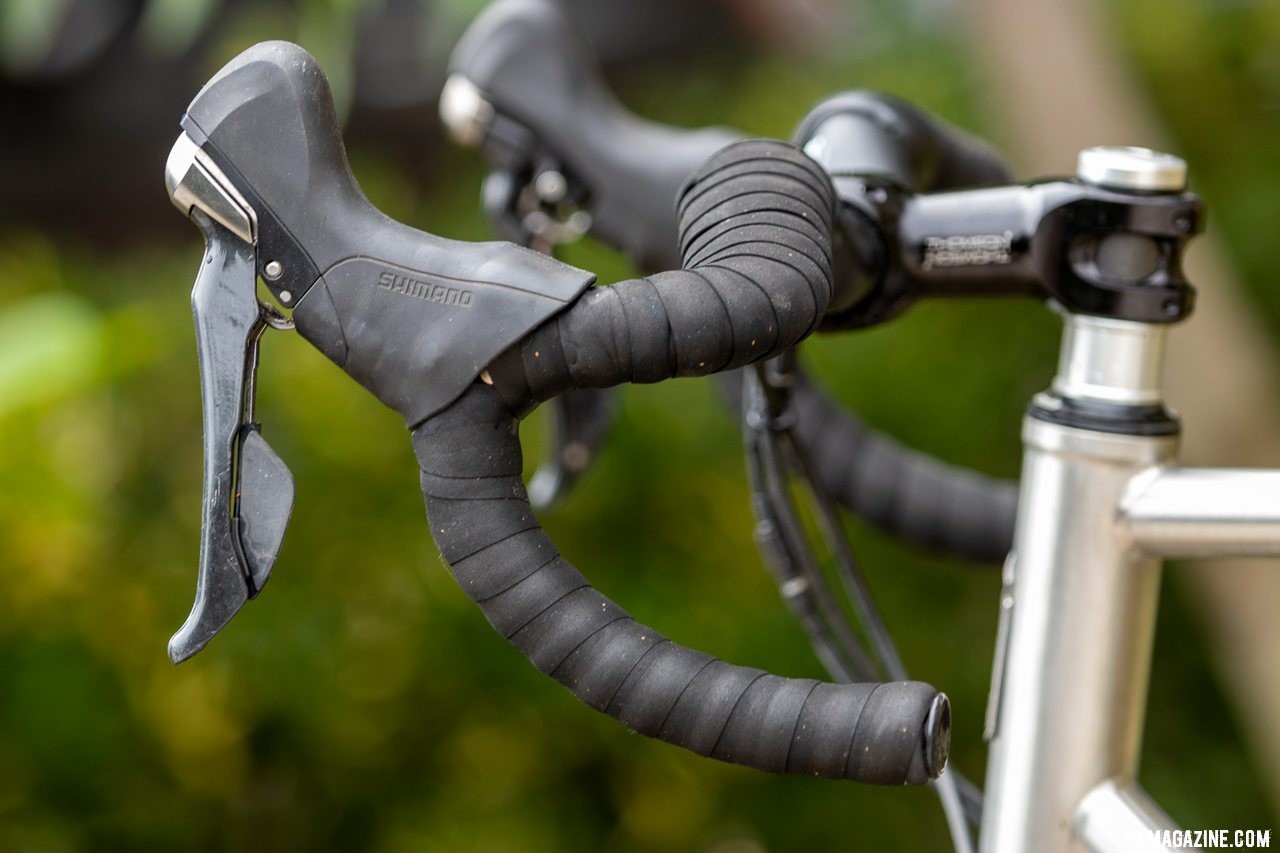
The Wave carbon handlebar from Coefficient Cycling offers a relatively normal position in the hoods. © A. Yee / Cyclocross Magazine
Out on the hoods, the position feels normal. You might never notice you’re riding a unique bar if you spend all your time in the hoods. The levers sit nearly vertical—there’s no severe angle due to dramatic bar flare—and the reach and width feel familiar.
It’s a small missed opportunity, though, at least in my hands’ humble opinion. Carbon allows for molded shapes, and the Wave handlebar could have gone further from the norm for comfort. My palms have found a happy home in the ergonomic contours behind the hoods on the FSA Metron 40 handlebar and its FSA K-Wing AGX sister, and I wished Coefficient Cycling took a similar approach.
Dropping In
The Wave handlebar’s drops are where I ran into an issue specific to my setup.
On paper, the 120mm drop, 77mm reach, ergonomic bend and slight 1.6° flare all look relatively familiar. In riding, your thumb might find a new home. The drops have a nifty “notch” that offers a secure thumb lock when the riding gets bumpy.
Unfortunately, the significant backsweep of the tops paired with minimal flare in the drops put my hands in a position where my wrists would hit the rearward corner of the tops, just before the bar turns forward to the hoods.
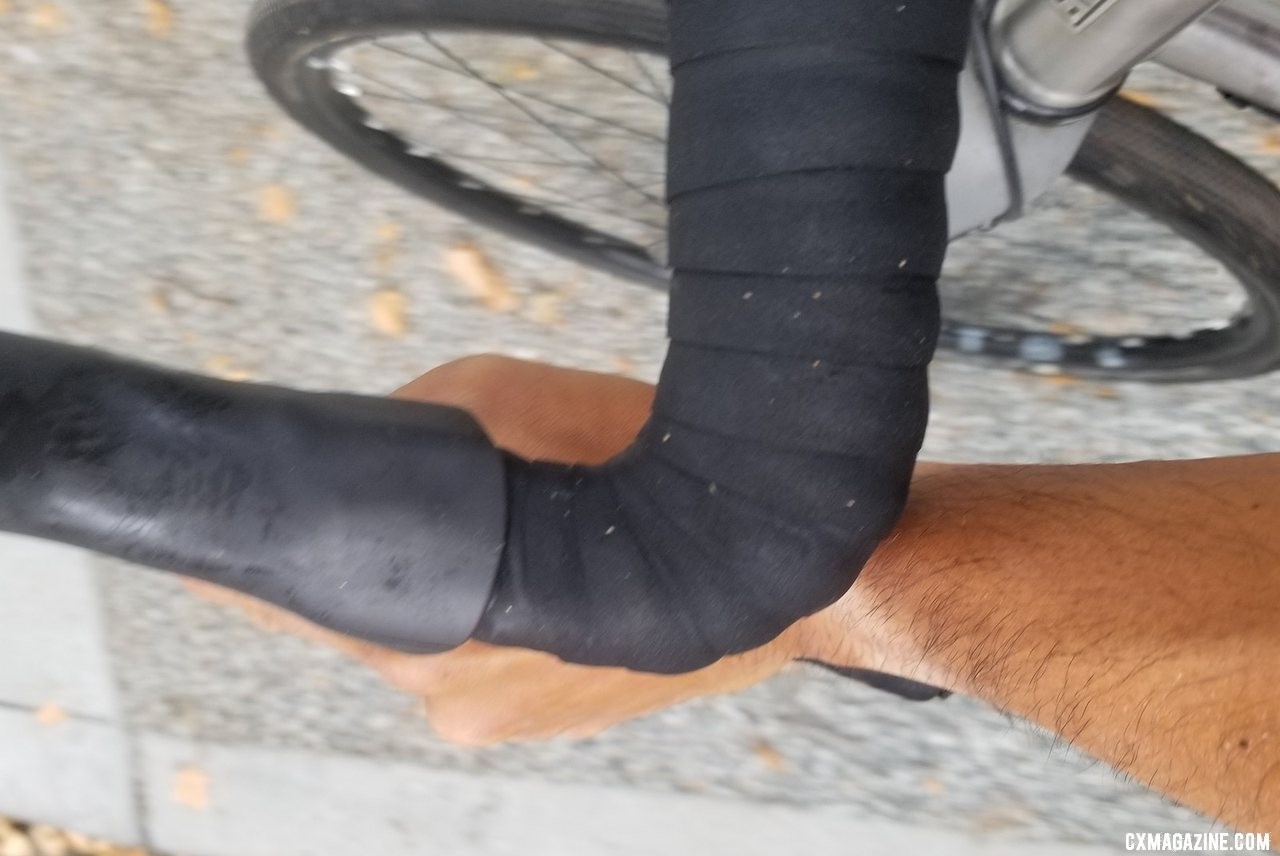
The sharp bend at the end of the tops has a chance to rub your wrists the wrong way. The Wave carbon handlebar from Coefficient Cycling. © A. Yee / Cyclocross Magazine
Study the various photos of my setup and you’ll come to the same conclusion as I have. It would be quite easy for me to modify my setup to avoid this. I could lower my tilted-up hood position that I prefer for offroad riding. Doing so would position my hands lower in the drops, at least for braking. I could also just rotate the whole handlebar forward a bit, effectively pulling my hands back a bit to give more clearance by my wrists. And I could also install a longer stem to reduce my arm angle.
However, like most cyclocrossers and gravel cyclists, I spend the majority of my time in the hoods, and center my riding position around that. In the drops on steep descents, it’s less of an issue, because I slide further back, decreasing my arm angle to the bars. It’s when I’m out of the saddle sprinting that I notice the wrist-rubbing the most. Out of the saddle, leaning forward and in the drops, the angle of my arms makes wrist contact inevitable.
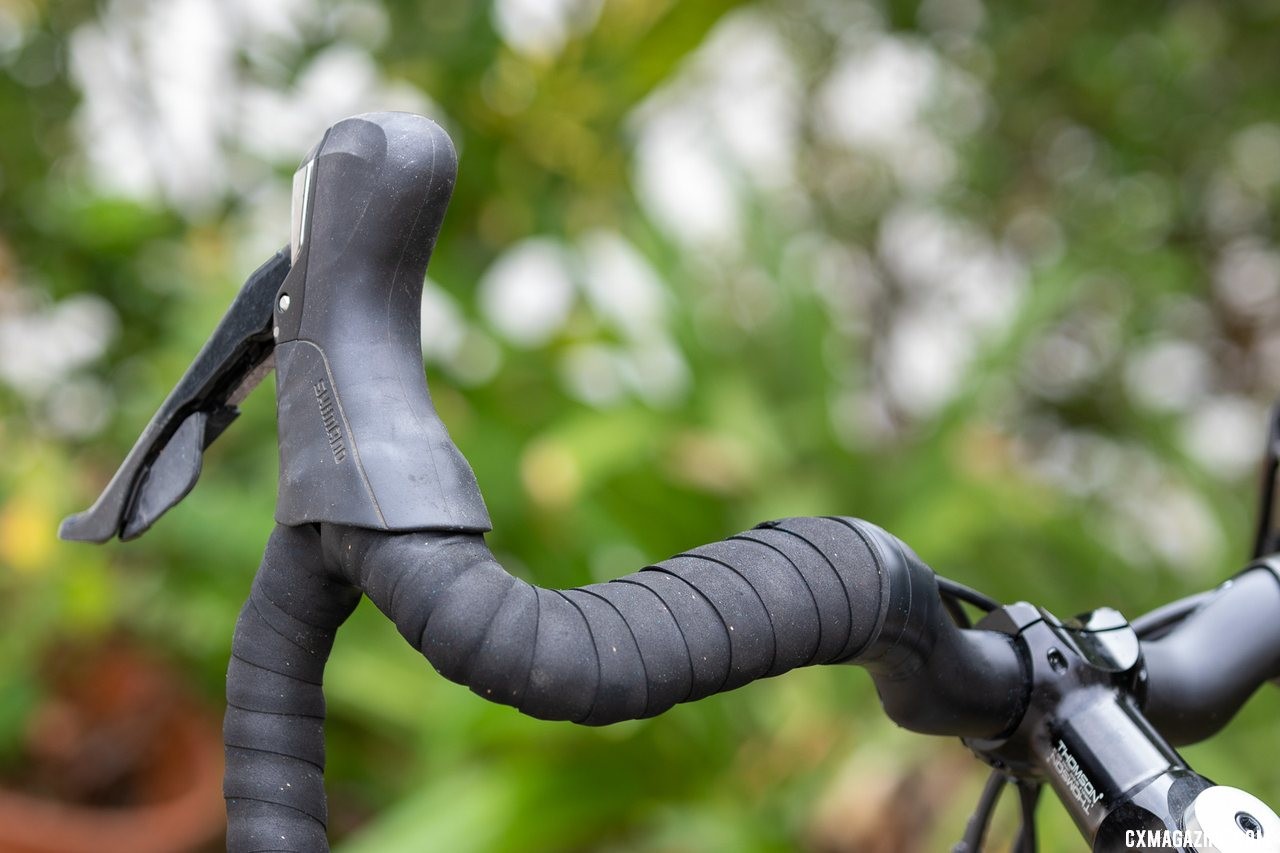
The backsweep and slope force a sharp bend towards the hoods. Wave carbon handlebar from Coefficient Cycling. © A. Yee / Cyclocross Magazine
Thankfully on the average ride, I don’t spend much time in the drops, and if I was to build a bike for cruising on the road or gravel, the comfort of the bar’s flats is worth the occasional wrist rub. I could feel it, but with padded bar tape, it didn’t hurt. And if you’re an old-school, levers-flat traditionalist, you probably will find riding in the drops to be rub-free and comfortable.
Wipeout or Winner?
Compared to just ten years ago, cyclocross and gravel cyclists are blessed with so many great options for equipment. The Wave handlebar is one such example. It adds a unique angle to a handlebar with a relaxed riding position, thanks to the sweep and slope on the bar’s tops.
I’ll keep the bar on the gravel bike. I like the position for longer rides, cruising around, breathing easy and seeing the sights. I wouldn’t want the sloped tops on my ’cross race bike, however.
Is riding the Wave worth $329? For a carbon bar, that’s competitive with bigger names charging $1 more for fewer curves.
More bends for your buck? That’s a slippery slope.
More info: coefficient.cc
Coefficient Cycling’s Wave Handlebar Photo Gallery:













